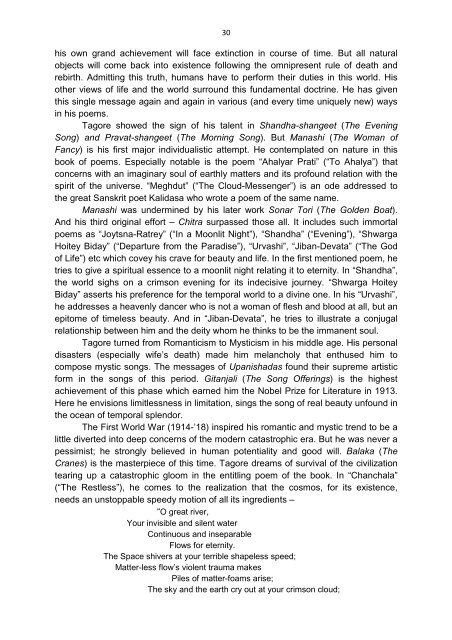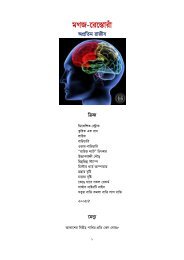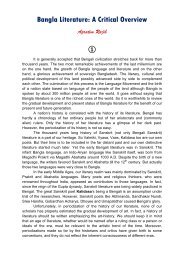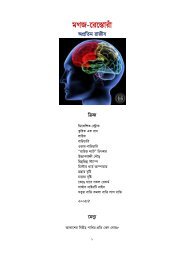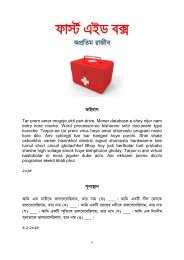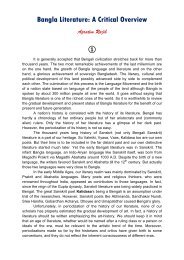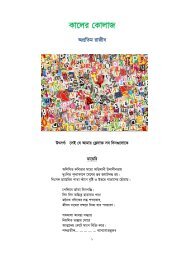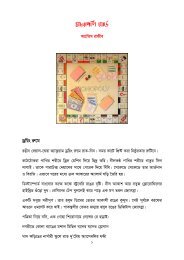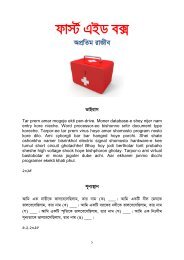BLiterature-Apratim
Create successful ePaper yourself
Turn your PDF publications into a flip-book with our unique Google optimized e-Paper software.
30<br />
his own grand achievement will face extinction in course of time. But all natural<br />
objects will come back into existence following the omnipresent rule of death and<br />
rebirth. Admitting this truth, humans have to perform their duties in this world. His<br />
other views of life and the world surround this fundamental doctrine. He has given<br />
this single message again and again in various (and every time uniquely new) ways<br />
in his poems.<br />
Tagore showed the sign of his talent in Shandha-shangeet (The Evening<br />
Song) and Pravat-shangeet (The Morning Song). But Manashi (The Woman of<br />
Fancy) is his first major individualistic attempt. He contemplated on nature in this<br />
book of poems. Especially notable is the poem “Ahalyar Prati” (“To Ahalya”) that<br />
concerns with an imaginary soul of earthly matters and its profound relation with the<br />
spirit of the universe. “Meghdut” (“The Cloud-Messenger”) is an ode addressed to<br />
the great Sanskrit poet Kalidasa who wrote a poem of the same name.<br />
Manashi was undermined by his later work Sonar Tori (The Golden Boat).<br />
And his third original effort – Chitra surpassed those all. It includes such immortal<br />
poems as “Joytsna-Ratrey” (“In a Moonlit Night”), “Shandha” (“Evening”), “Shwarga<br />
Hoitey Biday” (“Departure from the Paradise”), “Urvashi”, “Jiban-Devata” (“The God<br />
of Life”) etc which covey his crave for beauty and life. In the first mentioned poem, he<br />
tries to give a spiritual essence to a moonlit night relating it to eternity. In “Shandha”,<br />
the world sighs on a crimson evening for its indecisive journey. “Shwarga Hoitey<br />
Biday” asserts his preference for the temporal world to a divine one. In his “Urvashi”,<br />
he addresses a heavenly dancer who is not a woman of flesh and blood at all, but an<br />
epitome of timeless beauty. And in “Jiban-Devata”, he tries to illustrate a conjugal<br />
relationship between him and the deity whom he thinks to be the immanent soul.<br />
Tagore turned from Romanticism to Mysticism in his middle age. His personal<br />
disasters (especially wife’s death) made him melancholy that enthused him to<br />
compose mystic songs. The messages of Upanishadas found their supreme artistic<br />
form in the songs of this period. Gitanjali (The Song Offerings) is the highest<br />
achievement of this phase which earned him the Nobel Prize for Literature in 1913.<br />
Here he envisions limitlessness in limitation, sings the song of real beauty unfound in<br />
the ocean of temporal splendor.<br />
The First World War (1914-’18) inspired his romantic and mystic trend to be a<br />
little diverted into deep concerns of the modern catastrophic era. But he was never a<br />
pessimist; he strongly believed in human potentiality and good will. Balaka (The<br />
Cranes) is the masterpiece of this time. Tagore dreams of survival of the civilization<br />
tearing up a catastrophic gloom in the entitling poem of the book. In “Chanchala”<br />
(“The Restless”), he comes to the realization that the cosmos, for its existence,<br />
needs an unstoppable speedy motion of all its ingredients –<br />
“O great river,<br />
Your invisible and silent water<br />
Continuous and inseparable<br />
Flows for eternity.<br />
The Space shivers at your terrible shapeless speed;<br />
Matter-less flow’s violent trauma makes<br />
Piles of matter-foams arise;<br />
The sky and the earth cry out at your crimson cloud;


